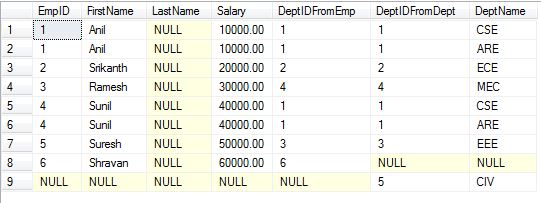Different types of joins in SQL
We
have three types of joins in SQL:
a.
INNER JOIN
b.
OUTER JOIN
c.
CROSS JOIN
To
understand how the joins work let us first create two table Employee
and Department:
CREATE
TABLE
[dbo].[Employee]
(
[EmpID]
[int]
NOT
NULL,
[FirstName]
[nvarchar](250)
NOT
NULL,
[LastName]
[nvarchar](250)
NULL,
[Salary]
[money]
NULL,
[DeptID]
[int]
NULL
)
INSERT
INTO
[dbo].[Employee]
(
[EmpID]
,[FirstName]
,[LastName]
,[Salary]
,[DeptID]
)
VALUES
(1,
'Anil',
NULL,
10000,
1)
,(2,
'Srikanth',
NULL,
20000,
2)
,(3,
'Ramesh',
NULL,
30000,
4)
,(4,
'Sunil',
NULL,
40000,
1)
,(5,
'Suresh',
NULL,
50000,
3)
,(6,
'Shravan',
NULL,
60000,
6)
CREATE
TABLE
[dbo].[Department]
(
[DeptID]
[int]
NOT
NULL
,[DeptName]
[nvarchar](50)
)
INSERT
INTO
[dbo].[Department]
(
[DeptID]
,[DeptName]
)
VALUES
(1,
'CSE')
,(2,
'ECE')
,(3,
'EEE')
,(4,
'MEC')
,(5,
'CIV')
,(1,
'ARE')
a.
INNER JOIN:
It
will give only the matching records from both the tables on the basis
of joining column.
In
this, joining column from the first table will be matched with the
joining column from the second table for each and row available in
the second table and only the matching records will be returned.
Most of the people think like we don't get more than number of rows available in joining tables.
That is if we have 4 rows in left table and 3 rows in right table then we may think like we will get maximum of 4 rows but that is not true.
Go through below example to know how we will get more number rows than we have in both the tables.
That is if we have 4 rows in left table and 3 rows in right table then we may think like we will get maximum of 4 rows but that is not true.
Go through below example to know how we will get more number rows than we have in both the tables.
SELECT
E.[EmpID]
,E.[FirstName]
,E.[LastName]
,E.[Salary]
,E.[DeptID]
AS
DeptIDFromEmp
,D.[DeptID]
AS
DeptIDFromDept
,D.[DeptName]
FROM
[dbo].[Employee]
E
INNER
JOIN
[dbo].[Department]
D
ON
E.[DeptID]
=
D.[DeptID]
Before
looking at the result set returned by this query, guess how many
rows this query will return.
Number
of rows returned by this query is not equal to the number of rows
available in left table (i.e)6.
Why
because here the joining column is DeptID and for DeptID = 1 we have
two matching rows from the right table. So it will return two rows
for the record with DeptID = 1 form the left table that's why we will see more number of rows than present in
left table.
Result:
b.
OUTER JOIN:
We
have three types of joins in this.
- LEFT OUTER JOIN
- RIGHT OUTER JOIN
- FULL OUTER JOIN
In
all these commands OUTER clause is optional, we need not to mention that in our query
just we can write LEFT JOIN, RIGHT JOIN, FULL JOIN.
I.
LEFT JOIN:
It
will give all records from the left table and only matching records from right table.
If
any value is not matching with the right table then it will return
NULL value in the column coming from the right table.
SELECT
E.[EmpID]
,E.[FirstName]
,E.[LastName]
,E.[Salary]
,E.[DeptID]
AS
DeptIDFromEmp
,D.[DeptID]
AS
DeptIDFromDept
,D.[DeptName]
FROM
[dbo].[Employee]
E
LEFT
JOIN
[dbo].[Department]
D
ON
E.[DeptID]
=
D.[DeptID]
Result:
If
we see the result set for DeptID coming from Employee (DeptIDFromEmp)
table we have value 6 in the last row and for the DeptID column
(DeptIDFromDept) coming from Department table we have NULL value
because for that value we don’t have any matching record from right
table where as from the left table we have some value that is the
reason it is showing up in the column coming from left table but not
in the column coming from right table.
II.
RIGHT JOIN:
It
will give all the records from right table and only the matching records from left table.
If
any value is not matching with the left table then it will return
NULL value in the column coming from the left table.
SELECT
E.[EmpID]
,E.[FirstName]
,E.[LastName]
,E.[Salary]
,E.[DeptID]
AS
DeptIDFromEmp
,D.[DeptID]
AS
DeptIDFromDept
,D.[DeptName]
FROM
[dbo].[Employee]
E
RIGHT
JOIN
[dbo].[Department]
D
ON
E.[DeptID]
=
D.[DeptID]
Result:
III.
FULL JOIN:
It's
a combination of both LEFT and RIGHT join that means it will give all
matching records from both the tables, non matching records from left
table (in this case it will insert NULL values in the columns coming from the left table) and non matching records from right table (in this case it will insert NULL values in the columns coming from the right table).
SELECT
E.[EmpID]
,E.[FirstName]
,E.[LastName]
,E.[Salary]
,E.[DeptID]
AS
DeptIDFromEmp
,D.[DeptID]
AS
DeptIDFromDept
,D.[DeptName]
FROM
[dbo].[Employee]
E
FULL
JOIN
[dbo].[Department]
D
ON
E.[DeptID]
=
D.[DeptID]
Result:
CROSS
JOIN:
It
will return all the records from the right table for each record in
left table.
For
example if we have 2 rows in left table and 3 rows in right table
then each record will be mapped with all the records from the right
table so we will get 2*3 = 6 records.
Here
we need not to mention any ON condition as it matches each record
from left table with all the records from right table.
SELECT
E.[EmpID]
,E.[FirstName]
,E.[LastName]
,E.[Salary]
,E.[DeptID]
AS
DeptIDFromEmp
,D.[DeptID]
AS
DeptIDFromDept
,D.[DeptName]
FROM
[dbo].[Employee]
E
CROSS
JOIN
[dbo].[Department]
D
Result:
Hope you understood the joins, if you still have any questions please comment.
Labels: cross join, differences between joins, full join, inner join, joins in sql, left join, right join, SQL Basics, sql joins, SQL Learning, SQL Query






0 Comments:
Post a Comment
Subscribe to Post Comments [Atom]
<< Home